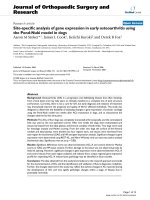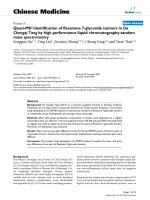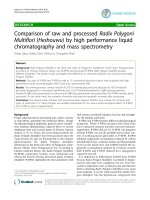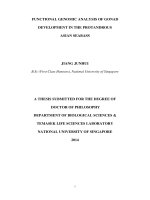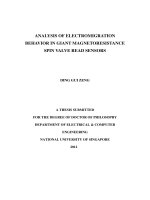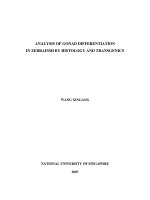Residue analysis of orthosulfamuron herbicide in fatty rice using liquid chromatography–tandem mass spectrometry
Bạn đang xem bản rút gọn của tài liệu. Xem và tải ngay bản đầy đủ của tài liệu tại đây (723.73 KB, 6 trang )
Journal of Advanced Research (2015) 6, 511–516
Cairo University
Journal of Advanced Research
SHORT COMMUNICATION
Residue analysis of orthosulfamuron herbicide
in fatty rice using liquid chromatography–tandem
mass spectrometry
Young-Jun Lee a, Jeong-Heui Choi a, A.M. Abd El-Aty a,b,c,*, So Jeong Im a,
Md. Musfiqur Rahman a, Sung-Woo Kim a, Jae-Han Shim a,*
a
Biotechnology Research Institute, Chonnam National University, 77 Yongbong-ro, Buk-gu, Gwangju 500-757, Republic of Korea
Department of Pharmacology, Faculty of Veterinary Medicine, Cairo University, 12211 Giza, Egypt
c
Department of Veterinary Pharmacology and Toxicology, College of Veterinary Medicine, Konkuk University,
Seoul 143-701, Republic of Korea
b
A R T I C L E
I N F O
Article history:
Received 20 May 2014
Received in revised form 10 June 2014
Accepted 17 June 2014
Available online 26 June 2014
Keywords:
Herbicide
Orthosulfamuron
Fatty rice
Rice straw
QuEChERS
LC/MS/MS
A B S T R A C T
In the present study, orthosulfamuron residues were extracted from fatty (unpolished) rice and
rice straw using a modified QuEChERS method and analyzed using liquid chromatography–
tandem mass spectrometry. The matrix-matched calibration was linear over the concentration
ranges of 0.01–2.0 mg/kg with determination coefficient (R2) P 0.997. The recovery rates at
two fortification levels (0.1 and 0.5 mg/kg) were satisfactory and ranged between 88.1% and
100.6%, with relative standard deviation (RSD) <8%. The limit of quantitation, 0.03 mg/kg,
was lower than the maximum residue limit, 0.05 mg/kg, set by the Ministry of Food and Drug
Safety in the Republic of Korea. The developed method was applied successfully to field samples harvested at 116 days and none of the samples were positive for the residue.
ª 2014 Production and hosting by Elsevier B.V. on behalf of Cairo University.
Introduction
* Corresponding authors. Tel.: +20 2 27548926; fax: +20 2 35725240
(A. M. Abd El-Aty). Tel.: +82 62 530 2135; fax: +82 62 530 0219
(J. H. Shim).
E-mail addresses: (A. M. Abd El-Aty),
(J. H. Shim).
Peer review under responsibility of Cairo University.
Production and hosting by Elsevier
Rice is one of the most consumed grains in the world. As its
consumption has been increased in accordance with population growth, the use of pesticides, including pre- and postemergence herbicides, insecticides, and fungicides, raised
consequently to improve its production during the various
stages of cultivation [1]. In the Republic of Korea, the main
pesticides employed are herbicides (before rice transplantation)
and fungicides or insecticides, depending upon the conditions
(rain or insect attack). After harvesting, several steps are
2090-1232 ª 2014 Production and hosting by Elsevier B.V. on behalf of Cairo University.
/>
512
needed to produce the final marketing products; including
paddy, brown, and white rice [2]. As the nutritional components are mainly exit in the germ and bran layers, the nutritional quality of various rice forms is diverse. In rice, the
high and low molecular weight components are either enhancing the response or interfering with compound identification
and quantitation in chromatographic analysis [3]. Rice straw,
which is separated from rice grains by a combine tractor,
was used as a feed for livestock production in the Republic
of Korea. So far, little is known on which proportion of the
pesticide originally applied in the field could be found in various types of rice and rice straw, which necessitates residue
analysis.
Orthosulfamuron, one of the sulfonylureas (SUs), is a selective and systemic early post-emergence herbicide, which is
absorbed by foliage and root and translocated apoplastically
and symplastically into the plants. It inhibits acetolactate synthase (ALS) enzyme, which catalyzes the first committed step
in the branched-chain amino acids (valine, isoleucine, and leucine) biosynthetic pathway and hence stop cell division and
plant growth [4]. ALS-inhibiting herbicides are important in
all crops due to their efficiency at low rates, flexibility of use,
favorable environmental profile, and low mammalian toxicity
[5] compared to other alternative herbicides [6]. Orthosulfamuron controls the post-emergence of annual and perennial
broad leaves weeds, sedges and barnyard grass, in dry and
water-seeded and transplanted rice [4]. It is therefore, possible
that the residues of this herbicide may contaminate and be
accumulated in grains, including barely, wheat, rice, and soybeans [7]. Because of their low application rates and thermal
instability, the determination of SU residues continues to present an analytical challenge, which promotes the development
of sample pre-treatment and analytical detection [8,9].
High-performance liquid chromatography (HPLC) with an
UV or diode array, mass spectrometry (MS) or tandem mass
spectrometry (MS/MS) detection system was the most common approach for the determination of SUs in grains because
of their polar characteristic, low volatility, and thermal instability [8,10–12]. In the literature survey, orthosulfamuron has
been analyzed neither as a single nor among multiple residue
analysis in grains. In this study, a simple liquid chromatography–tandem mass spectrometry (LC/MS/MS) method was
established to detect the residues of orthosulfamuron in brown
fatty (unpolished rice) and rice straw using the QuEChERS as
an extraction method.
Y. J. Lee et al.
Matrix-matched calibration
Orthosulfamuron stock solution was prepared in MeCN at
a concentration of 1000 lg/mL. A working solution of
10 lg/mL was prepared by diluting the stock solution with
blank rice or rice straw extracts, which were confirmed previously to be free of the target analyte. A matrix-matched
calibration was prepared by mixing the working standard
solution with blank sample extracts to reach a concentration
range of 0.01–2 mg/kg. Stock solution was stored at À26 °C
in a dark amber bottle, whereas calibration standards were
kept at 4 °C.
Field trails
Experimental field trials were carried out at Chonnam
National University, Gwangju, Republic of Korea. The onfarm research product, tablet for direct application (DT) of
1.5% orthosulfamuron, was applied to two paddy field plots
at two different doses on fifteen days after transplanting the
rice seedlings. The first plot received the herbicide at the recommended dose of 500 g/10 a (a.i. [active ingredient]
0.0075 kg/10 a) (T1) and the second one was sprayed with double the recommended dose 1000 g/10 a (a.i. 0.015 kg/10 a)
(T2), along with the untreated control (T3). Representative
rice (800 g) and rice straw (500 g) samples were collected at
harvest (116 days) from the treated and untreated plots. The
collected rice and straw were dried to approximately 12%
moisture content in a drying room. Subsequently, the dried
grains were incompletely husked to make unpolished rice.
Unpolished rice grains and straw samples were then ground
using a mechanical grinder and used for residue analysis.
The samples were stored at À20 °C until analyzed.
Sample preparation
Sample preparations for fatty rice and rice straw were based on
the acetate-buffering QuEChERS method [13] following minor
modifications. At no point the extraction conditions were optimized. Rather, the experimental variables including solvents,
salting out agents, and cleanup procedure were predicated
based on our experience.
Unpolished fatty rice
Experimental
Chemicals and reagents
Orthosulfamuron of purity 99.34% was kindly donated from
KYUNG NONG CO. LTD. (Seoul, Republic of Korea).
HPLC-grade acetonitrile (MeCN) was supplied by Burdick
and Jackson (Ulsan, Republic of Korea). Sodium acetate
(NaOAc, purity 98.0%) and anhydrous magnesium sulfate
(MgSO4, purity 99.5%) were provided by Junsei Chemical
Co. Ltd. (Kyoto, Japan). Sodium chloride (NaCl, purity
99.5%) was obtained from Merck (Darmstadt, Germany). Primary secondary amine (PSA) and C18 were supplied by Agilent
Technologies (Palo Alto, CA, USA). All other chemicals were
of analytical and/or HPLC grade.
Ten grams of well-ground rice sample was placed into a 50-mL
Teflon centrifuge tube. Ten milliliters of distilled water was
added to the tube and then vortex-mixed for 1 min. Afterward,
MeCN (20 mL), NaCl (2 g), MgSO4 (4 g), and NaOAc (1.5 g)
were added to the mixture and shaken by a vortex-mixer for
2 min. The extract was centrifuged for 5 min at 5000 rpm
and 5 °C, and the supernatant was aspirated into a 1.5-mL
microcentrifuge tube that contained 0.03 g of both PSA and
C18. Following shaking for 1 min, the tubes were centrifuged
for 5 min at 5000 rpm. The purified extract was subjected to
filtration using a polytetrafluoroethylene (PTFE) membrane
filter (0.2 lm, ADVANTECÒ, Toyo Roshi Kaisha, Ltd.,
Tokyo, Japan) and 1 mL of the extract was ready for analysis
using LC/MS/MS.
Analysis of orthosulfamuron in rice and rice straw
513
Five grams of sample was placed into a 250-mL Erlenmeyer
flask, to which MeCN (100 mL), distilled water (50 mL), NaCl
(10 g,) MgSO4 (10 g), and NaOAc (5 g) were added. After
vigorous shaking for 1 min, the mixture was kept in a shaking
incubator for 30 min. The mixture was vacuum filtered through
a filter paper (Whatman No. 6, GE Healthcare Co. Ltd.,
Buckinghamshire, UK) and Celite 545 (Junsei Chemical Co.
Ltd., Kyoto, Japan), and 15 mL filtrate was transferred to a
15-mL Teflon centrifuge tube to which MgSO4 (1 g), PSA
(0.5 g), and C18 (0.5 g) were added. The tube was vigorously
shaken for 1 min and centrifuged for 5 min at 5000 rpm. Ten
milliliters of supernatant was vacuum evaporated under 40 °C
until dryness and then redissolved with 1 mL MeCN. The
extract was filtered with a membrane filter (PTFE, 0.2 lm)
and 1 mL portion was prepared for LC/MS/MS analysis.
standard working solutions prepared in a pure MeCN and in
matrix extracts. ME (%) was calculated as follow: (B/
A) · 100, where B is a slope of matrix-matched calibration
curve, and A is a slope of non-matrix-matched calibration
curve [14]. Each matrix-matched calibration curve was created
at concentrations of 0.01, 0.02, 0.1, 0.2, 1, and 2 mg/kg, and
determination coefficient (R2) of the matrix-matched calibration curve was used to assess linearity. Limits of detection
(LOD) and quantitation (LOQ) were determined based on a
signal-to-noise ratio, and concentrations showing peak intensity of signal-to-noise ratio 3 and 10 were designated as
LOD and LOQ, respectively. Recovery test was performed
with blank samples at 0.1 and 0.5 mg/kg, in triplicate. Percent
rate of recovery was obtained by comparing an extracted concentration with a true value. The extracted concentration was
calculated by the matrix-matched calibration curve substituting orthosulfamuron peak area detected.
LC/MS/MS
Storage stability of orthosulfamuron
The LC/MS/MS system consisted of a Waters Alliance 2695
LC Separations Module and a Micromass Quattro Microtriple
quadrupole tandem mass (Waters Crop., Milford, MA, USA).
The analytes were separated on a Gemini C18 (2.0 mm
i.d · 50 mm, 3.0 lm, Phenomenex, CA, USA). A binary solvent system containing 0.1% formic acid in MeCN (mobile
phase A) and 50 mM ammonium acetate in water (mobile
phase B) was run in a gradient mode to detect orthosulfamuron. A linear mobile phase gradient started at 5% A (0–
1 min), increased to 50% A (1–3 min), increased to 90% A
(3–6 min), maintained at 90% A (6–8 min), decreased to 5%
A (8–8.1 min), and maintained at 5% A (8.1–12 min). Flow
rate and injection volume were set to 0.25 mL/min and 5 lL,
respectively. The MS positive electrospray ionization source
conditions were as follows: capillary voltage, 3.3 kV; RF lens
voltage, 0.2 V; source temperature, 150 °C; desolvation temperature, 370 °C; desolvation gas (N2) flow, 600 L/h; cone
gas (N2) flow, 50 L/h; and collision gas (argon) 0.15 mL/min.
Mass Lynx V4.1 software (Waters Corp.) was used for instrument control, data acquisition, and processing.
Rice grains and straws have been kept under À20 °C for
97 days until the analysis since collected after drying. In order
to evaluate stability of the analyte in the samples during this
storage time (97 days), standard working solution was spiked
onto the samples at 0.5 mg/kg, sealed, and kept under
À20 °C. The stored fortified samples were extracted, and stability was expressed in terms of a percentage in the same manner as the recovery test.
Rice straw
Method validation
Matrix effect (ME) was assessed by comparing each slope
generated from calibration curves, which were created with
Results and discussion
Sample preparation and LC/MS/MS analysis
Sulfonylurea herbicides have been traditionally extracted by
liquid–liquid extraction (LLE) and solid-phase extraction
(SPE); however, these extraction methods have undesirable
features, such as time-consuming and multi-step procedures,
and large consumption and discharge of organic solvents
[8,10–12]. On the other hand, the use of the QuEChERS
method has been effectively improving the demerits of traditional extraction methods because of its small scale LLE, dispersive SPE, and a combination with mass spectrometry
[13,15]. Therefore, the present study first introduced the
original QuEChERS method to extract orthosulfamuron from
unpolished rice and straw samples. The original QuEChERS
a
Pesticide
Precursor ion
(m/z)
Product ion (m/z)
Quantitation
425
+
199 227
[M + H]
a
Both monitoring at cone voltage 24 V and collision energy 3 V
Orthosulfamuron
Fig. 1
Confirmation
Ion ratio
0.58
Chemical structure and MRM mode of orthosulfamuron in LC/MS/MS.
514
Y. J. Lee et al.
method not using buffers resulted in poor recoveries ranging
62–78%. Subsequently, the AOAC QuEChERS method buffering acetate was employed with minor modifications, and
successful outcomes were generated with good recoveries.
Therefore, the acetate-buffering QuEChERS method was used
to extract orthosulfamuron in rice and straw samples, and
more volume of MeCN was needed for straw samples due to
their large volume per unit mass.
According to European Decision 657/2002/EC [16], confirmation of organic residues using tandem mass spectrometry is
based on identification points (IPs), ion ratio, and retention
time. The requested IPs are three or four (if a substance is
banned), and each precursor and product ion records IP 1
and 1.5, respectively. In this respect, the MRM mode using
two transitions is required, resulting in four IPs and an ion
ratio of signals detected between MRM 1 and MRM 2. All
necessary ions of orthosulfamuron were identified by direct
infusion of a working standard solution (0.5 mg/L). As shown
in Fig. 1, the protonated ion of orthosulfamuron was m/z 425
of [M+H]+, and the product ions were m/z 199 (quantitative)
and m/z 227 (qualitative). The ion ratio comparing MRM 1
(m/z 425 fi 199) and MRM 2 (m/z 425 fi 227) was 0.58 that
should match that of the sample within 1.7% tolerance.
Method performance and storage stability of orthosulfamuron
All validation results are noted in Fig. 2 and Table 1. The calculated ME was 79.4% and 40.9% for unpolished rice and
straw, respectively, implying a severe suppression effect caused
by matrices on positive electrospray ionization of orthosulfamuron. Hence, matrix-matched calibration was essential to minimize quantitative errors in the present study.
Specificity was tested by analyzing blank samples to ascertain the absence of potential interfering compounds at the
retention time of orthosulfamuron. No interfering peaks were
observed at the retention time as shown in Fig. 2.
(I) Fatty rice
(II) Rice straw
Fig. 2 Typical LC/MS/MS chromatograms of orthosulfamuron in unpolished rice (I) and rice straw (II) containing no detectable residue
in untreated rice or rice straw (A); blank rice or rice straw fortified at 0.5 mg/kg of orthosulfamuron (B); and 116 days incurred samples
after treatment at the recommended dose (a.i. 0.0075 kg/10 a) (C).
Analysis of orthosulfamuron in rice and rice straw
515
Table 1 Matrix effect (ME), determination coefficient (R2), spiking levels (mg/kg), recovery (%), relative standard deviations
(RSD%), limit of detection (LOD, mg/kg), limit of quantification (LOQ, mg/kg), and storage stability of orthosulfamuron in
unpolished rice and straw using a QuEChERS–LC/MS/MS method (n = 3).
Sample
Unpolished rice
Rice straw
ME (%)
79.4
40.9
R2
0.999
0.997
Recovery (RSD, %)
LOD (mg/kg)
0.1 mg/kg
0.5 mg/kg
92.7 (5.4)
100.6 (4.2)
88.8 (5.6)
88.1 (7.7)
Each linearity for orthosulfamuron in unpolished rice and
rice straw was validated with the determination coefficient
(R2) resulted from a calibration curve in a range of 0.01–
2 mg/kg. All the determination coefficients were higher than
0.997 and linearity was good and reliable.
LODs and LOQs were measured to evaluate sensitivity of
the present study. Each LOD and LOQ values were 0.01 and
0.03 mg/kg both in unpolished rice and rice straw. The LOQ
was low enough compared with the maximum residue level
(MRL) (0.05 mg/kg) of orthosulfamuron in rice grains set by
the Ministry of Food and Drug Safety [17].
Recovery tests were carried out at two different concentrations (0.1 and 0.5 mg/kg) in three replicates. The recoveries of
the orthosulfamuron were good and ranged between 88.1%
and 100.6% with RSD values 68%. The current results were
consistent with the acceptable range specified by SANCO
Guidelines [18].
The fortified (0.5 mg/kg) and stored (À20 °C, 97 d) unpolished rice and rice straw samples were extracted and detected,
and recovery rates were from 92.7% to 103.3% with RSDs
66%. The recovery values of the stored samples were approximately similar to those of freshly prepared samples. We could
imply that orthosulfamuron was not degraded under storage
conditions.
Determination of orthosulfamuron in field-incurred samples
The developed method was applied for the detection of orthosulfamuron in paddy field following single and double dose
application. Neither rice nor rice straw, harvested after
116 days following rice transplantation, contains orthosulfamuron residue levels (Fig. 2).
Conclusions
The method developed was simple and reliable and was used to
accurately detect orthosulfamuron residues in a rice paddy
field. Orthosulfamuron applied at the recommended dose or
up to double the recommended dose was not detected in rice
grains or rice straw.
Conflict of interest
The authors have declared no conflict of interest.
Compliance with Ethics Requirements
This article does not contain any studies with human or animal
subjects.
LOQ (mg/kg)
Storage stability
0.5 mg/kg
0.01
0.01
0.03
0.03
92.7 (5.3)
103.3 (4.7)
Acknowledgment
This study was supported by the MSIP (Ministry of Science,
Ict & future Planning.
References
[1] Pareja L, Cesio V, Heinzen H, Ferna´ndez-Alba AR. Evaluation
of various QuEChERS based methods for the analysis of
herbicides and other commonly used pesticides in polished rice
by LC–MS/MS. Talanta 2011;83:1613–22.
[2] Pareja L, Colazzo M, Pe´rez-Parada A, Besil N, Heinzen H,
Bo¨cking B, et al. Occurrence and distribution study of residues
from pesticides applied under controlled conditions in the field
during rice processing. J Agric Food Chem 2012;60(18):4440–8.
[3] Zhang WG, Chu XG, Cai HX, An J, Li CJ. Simultaneous
determination of 109 pesticides in unpolished rice by a
combination of gel permeation chromatography and Florisil
column
purification,
and
gas
chromatography/mass
spectrometry. Rapid Commun Mass Spectrom 2006;20(4):
609–17.
[4] MacBean C. The pesticide manual. 16th ed. Hampshire,
UK: British Crop Production Council; 2012.
[5] Shaner DL. Resistance to Acetolactate Synthase (ALS)inhibiting in the United States: history, occurrence, detection,
and management. J Weed Sci Technol 1999;44:405–11.
[6] Merotto Jr A, Jasieniuk M, Osuna MD, Vidotto F, Ferrero A,
Fischer AJ. Cross-resistance to herbicides of five ALS-inhibiting
groups and sequencing of the ALS gene in Cyperus difformis L. J
Agric Food Chem 2009;57(4):1389–98.
[7] Furlong ET, Burkhardt MR, Gates PM, Werner SL, Battaglin
WA. Routine determination of sulfonylurea, imidazolinone, and
sulfonamide herbicides at nanogram-per-liter concentrations by
solid-phase extraction and liquid chromatography/mass
spectrometry. Sci Total Environ 2000;248:135–46.
[8] Kang S, Chang N, Zhao Y, Pan C. Development of a method
for the simultaneous determination of six sulfonylurea
herbicides in wheat, rice, and corn by liquid chromatography–
tandem mass spectrometry. J Agric Food Chem 2011;59(18):
9776–81.
[9] Springer VH, Aprile F, Lista AG. Determination of
sulfonylureas in cereal samples with electrophoretic method
using ionic liquid with dispersed carbon nanotubes as
electrophoretic buffer. Food Chem 2014;143:348–53.
[10] Akiyama Y, Yoshioka N, Tsu M. Determination of ten
sulfonylurea herbicides in unpolished rice by solid-phase
extraction cleanup and LC-diode array detection. J Food Hyg
Soc Jpn 2002;43(2):99–103.
[11] Qi Y, Li S, Zhan C, Peng T. Simultaneous determination of
sulfonylurea herbicides residues in soybeans by high
performance liquid chromatography–mass spectrometry. Fenxi
Huaxue 2004;32(11):1436–40.
[12] Wang H, Li Y, Yong L, Gu S, Yang X, Li L. Simultaneous
determination of sulfonylurea and diphenylether herbicide
516
residues in soybean and rice by high performance liquid
chromatography. Se Pu 2007;25(4):536–40 [Chinese].
[13] Lehotay SJ, Masˇ tovska` K, Lightfield AR. Use of buffering and
other means to improve results of problematic pesticides in a fast
and easy method for residue analysis of fruits and vegetables. J
AOAC Int 2005;88:615–29.
[14] Lee SW, Choi JH, Cho SK, Yu HA, Abd El-Aty AM, Shim JH.
Development of a new QuEChERS method based on dry ice for
the determination of 168 pesticides in paprika using tandem
mass spectrometry. J Chromatogr A 2011;1218:4366–77.
[15] Anastassiades M, Lehotay SJ, Sˇtajnbaher D, Schenck FJ. Fast
and easy multiresidue method employing acetonitrile extraction/
Y. J. Lee et al.
partitioning and ‘‘dispersive solid-phase extraction’’ for the
determination of pesticide residues in produce. J AOAC Int
2003;86:412–31.
[16] European Commission Decision 2002/657/EC.
[17] Ministry of Food and Drug Safety (MFDS). Maximum residue
limits (MRLs) of pesticide, Republic of Korea, 2013.
[18] SANCO. Document No. 12571. Guidance document on
analytical quality control and validation procedures for
pesticide residues analysis in food and feed; 2013.
